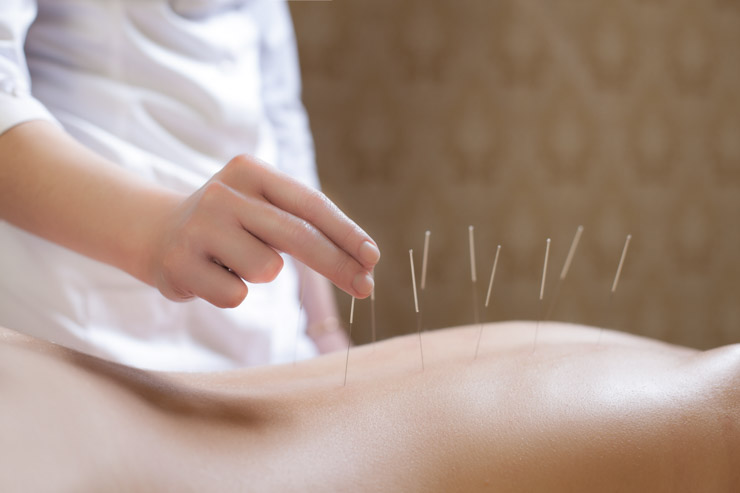Acupuncture is effective for the treatment of polycystic ovarian syndrome. Researchers find acupuncture effective for normalizing hormone levels and improving the overall health of patients with polycystic ovarian syndrome. Scientific data demonstrates that acupuncture produces significant improvements in menstrual regularity, restores ovulation pattern regularity, increases pregnancy rates, regulates hormonal secretions, normalizes basal body temperature patterns, and increases embryo survival rates. Fertility enhancements provided by acupuncture apply to both natural conception and IVF (in vitro fertilization) patients.
Research published in the Shanghai Journal of Acupuncture and Moxibustion entitled Advances In Clinical Research On Acupuncture Moxibustion Treatment For Polycystic Ovarian Syndrome cites several clinical studies. Let’s take a look at the finings. Chen et al. applied stimulation with acupuncture at sacral plexus acupoints and paraspinal acupoints. Acupuncture treatment sessions were regularly administered over the course of three menstruation cycles. Upon completion of all acupuncture therapy, follow-up examinations (including ultrasound imaging) demonstrated significant improvements in menstrual regularity, ovulation frequency, and cervical mucus consistency. In addition, the pregnancy rate of patients in the study increased significantly.

The research published in the Shanghai Journal of Acupuncture reviewed the work of Wang et al. That study demonstrated an 80.8% total effective rate for the treatment of polycystic ovarian syndrome with acupuncture. The acupuncture points used in the study included the following acupoints:
Geshu, BL17
Shenshu, BL23
Ganshu, BL18
Zhongwan, CV12
Qihai, CV6
Guanyuan, CV4
Zigong, extra
Guilai, ST29
Xuehai, SP10
Zusanli, ST36
Sanyinjiao, SP6
Dahe, KD12
Two additional acupuncture points were added, based on symptomatic presentations and differential diagnostic considerations: Taichong (LV3), Fenglong (ST40). In another investigation, Huang et al. combined moxibustion with traditional Chinese medicine massage (Tui Na) and medications. The controlled investigation demonstrated the ability of traditional Chinese medicine to regulate ovulation and secretion of sex hormones to normal levels when compared with the control group that received only drug therapy. Moxibustion was applied to the following: Sanyinjiao, Guanyuan, Zigong. The researchers conclude that moxa and Chinese massage enhance the efficacy of drug therapy for the treatment of polycystic ovarian syndrome.
Xie et al. combined traditional Chinese herbal medicine with acupuncture and achieved significant clinical results. Patients with polycystic ovarian syndrome had an 80% total treatment effective rate using the combined therapy protocol. An herbal pill (Zi Shen Yu Tai) was administered to nourish the kidneys and reinforce fertility. On the fifth day following menstruation, acupuncture was applied to the following acupoints:
Guanyuan, CV4
Sanyinjiao, SP6
Taixi, KD3
Taichong, LV3
Zigong, extra
The pattern of basal body temperatures significantly normalized using the herbal medicine combined with acupuncture therapy approach to patient care. In addition, hormone levels significantly normalized, including the following hormones: LH (luteinizing hormone), testosterone, FSH (follicle-stimulating hormone). The work of Xie et al. was published in the Guiding Journal of Traditional Chinese Medicine.
Qiu and Xu administered electroacupuncture to patients that had a combination of polycystic ovarian syndrome with obesity. Electroacupuncture was applied to body style acupuncture points. In addition, auricular (ear) acupuncture was added. Important clinical improvements were documented by the researchers. Patients had significant improvements in the reduction of polycystic ovarian syndrome symptoms, including improved menstruation regularity. In addition, many patients experienced a healthy reduction a bodily fat. The total treatment affective rate was 89.7%.The auricular acupuncture points used in the study were as follows: Zigong, Neifenmi, Pizhixia, Pi, Shen, Luanchao. Body style acupuncture points used in the study were as follows:
Zhigou, TB6
Siman, KD14
Guanyuan, CV4
Daimai, GB26
Xuehai, SP10
Sanyinjiao, SP6
Taixi, KD3
Li et al. administered acupuncture therapy to determine whether or not it is successful for the improvement of in vitro fertilization (IVF) embryo survival rates. Inclusion criteria for the study predetermined that all patients were of kidney deficiency type (according to Chinese medicine principles) and had a confirmed diagnosis of polycystic ovarian syndrome. The results demonstrate significant clinical improvements, including higher embryo survival rates. The following acupuncture points used in the study were as follows:
Guanyuan, CV4
Zhongji, CV3
Sanyinjiao, SP6
Zigong, extra
Taixi, KD3
In related research, Chengdu University of Traditional Chinese Medicine researchers investigated ovulation and pregnancy rates for patients with polycystic ovarian syndrome. The study involved two groups. Group one received acupuncture, herbs, and therapeutic exercises. Group two received drug therapy (cyproterone acetate / ethinylestradiol tablets and metformin). The acupuncture, herbs, and exercise group slightly outperformed the drug group.
The combination of acupuncture, herbs, and therapeutic exercises produced higher rates of ovulation and pregnancies in PCOS patients, producing a 46.92% ovulation rate and a 32.16% pregnancy rate. The drug therapy protocol produced a 40.61% ovulation rate and a 30.16% pregnancy rate. The researchers concluded that drug therapy and Chinese medicine produce similar positive patient outcomes for patients with PCOS.
The Healthcare Medicine Institute (HealthCMi) provides an online acupuncture continuing education course on the treatment of polycystic ovarian syndrome (PCOS) with acupuncture and herbs. The course is valid for 5 acupuncture CEUs / PDAs throughout the entire USA, Canada, New Zealand, and several other regions.
References
Zheng HM, Lv GY, Wang YJ, Hou WG, Chen YL, Zeng YJ. (2013). Advances in Clinical Research on Acupuncture moxibustion Treatment for Polycystic Ovarian Syndrome. Shanghai Journal of Acupuncture and Moxibustion. 32(9).
Wang XY, Zhang YJ, Wu FD, Lu Y & Huang GQ. (2007). Acupuncture Treatment for 26 Cases of Polycystic Ovary Syndrome. Journal of acupuncture, moxibustion & Tuina. (05).
Chen D, Chen SR, Shi XL, Guo FL, Zhu YK, Li Z, Cai MX, Deng LH & Xu H. (2007). Needle pricking therapy in treating polycystic ovary syndrome. China Journal of Acupuncture & Moxibustion. (02).
Huang M, Lai H, Lv FB & Pan BQ. (2007). Moxibustion in treating polycystic ovarian syndrome. Massage methodology. (01).
Qiu HN & Xu J. (2006). Acupuncture, moxibustion and auricular point sticking in treating obese polycystic ovarian syndrome. Chinese Community Doctors. 8(14): 86-87.
Li J, Cui W, Sun W. (2009). Electroacupuncture in treating patients with kidney deficiency type of PCOS and receive IVF-ET. China Journal of Sexual Science. (07).

![Diseases, Symptoms, tcm, [tcmwindow.com]](/uploadFile/adImg/2015/11/11/f5cbfcc0-4df5-4646-9b9a-f316651a0199.jpg)





